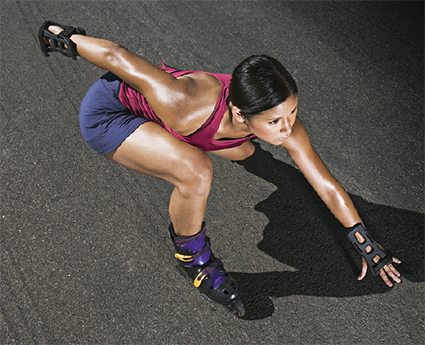Sweat Equity
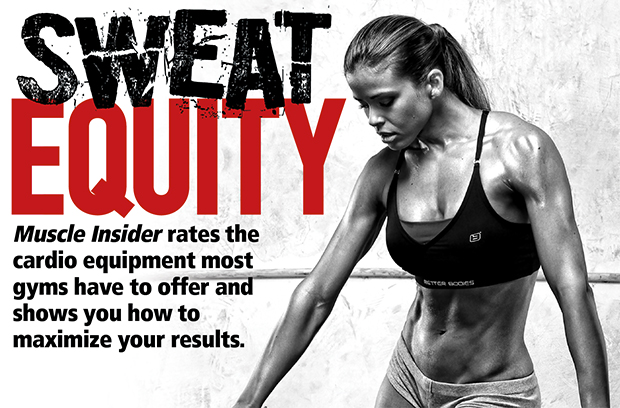
SWEAT EQUITY
Muscle Insider rates the cardio equipment most gyms have to offer and shows you how to maximize your results.
Walk into any gym and you’ll be confronted with row upon row of cardio equipment—large machines lined up like soldiers, just waiting for you to step on them and start sweating. But, among the sea of options, which do you pick?
Cardiovascular exercise is an important component of a healthy lifestyle and an unavoidable reality for people trying to lose body fat. It challenges your lungs and heart to improve your fitness level, yielding plenty of health benefits as these organs work more efficiently. As a tool for fat loss, it burns calories, which creates a greater deficit over the course of the day when paired with your training and diet protocol.
Each piece of equipment has its benefits and drawbacks, and has the potential to challenge your body in different ways. Which will target your trouble spots best, which is better on your joints, and which is going to burn the most calories? We’ve done the legwork for you and rounded up the five most common pieces of cardio equipment at a gym, examined their pros and cons, and have ranked them. Lace up your shoes and get ready to break a serious sweat—it’s time to get to work.

Stair Mill
Topping our list is none other than the stair mill. Anyone who has jumped on this machine knows how challenging it is. This large machine features a rotating set of stairs, and the user has the ability to change the speed at which they rotate toward you. Increasing or decreasing the speed depends on your fitness level. The stairs eliminate any ability to use momentum, and if you don’t keep up, the only place you’re going is off the back!
When it starts to get challenging, you may find yourself reaching for the railings, gradually transferring your weight onto your arms. By taking the weight off your legs, you’re lessening the work, making it easier and getting less out of your time on the machine. Don’t cheat yourself! Keep the work in your legs by standing up tall and focusing on your glutes with each step.
When it comes to the ability to burn calories and shape up the lower body, the stairs just cannot be beat.
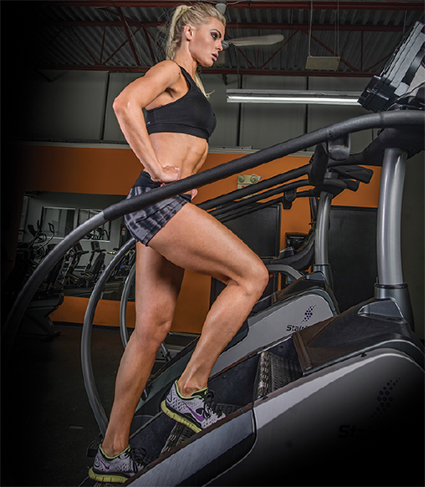
Not All Stair Climbers Are Created Equal
The stepper, a distant cousin to the stair mill, might seem to deliver the same punch, but it falls short. The pedals create much shallower steps, eliminating some of the burn in your legs and butt, as well as cutting down the number of calories expended overall. Go for the real deal on the stair mill if you’re looking for noticeable results and want to maximize the time you’re spending doing cardio.
Stair Mill Pros
• High calorie burner
• Intense work for the lower body
• No special coordination needed to climb stairs
• Incorporate intervals to increase the intensity of your workout
Stair Mill Cons
• Can be hard on the back and joints of the lower body
• Can easily cheat by using the railings to lean on, or pull yourself up each step
• Not all gyms have them (or they have very few)
Looking to step up your cardio session? Try this workout
Bumping up the speed in intervals as you get increasingly tired will challenge your cardio fitness and cause lactic acid to build in your legs. Can you push through it?
Warm up at a moderate pace
3 min. at level 7
2 min. at level 8
2 min. at level 9
1 min. at level 10
1 min. at level 11
2 min. at level 7 to recover
Can restart pyramid, or move into a cooldown
Don’t forget—hands off the railings and be sure to stretch your legs after!
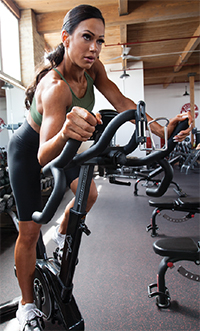 Spin Bike
Spin Bike
Has it been years since you got on a bike? If you’re looking for a solid cardio workout, it’s time to break out that childhood skill and start pedalling. Hands down, the biggest benefit to biking is the absence of impact. However, we can’t overlook the challenge it delivers to the lower body. Turning the resistance up, even to a moderate level, and alternating between sitting, standing, and hovering can make you feel the burn in the quads, hamstrings, and glutes. This variety takes the bike beyond a simple cardio session to a full workout.
For those who love a challenge, the spin bike is one of the few pieces of traditional gym equipment that allows you to perform a true HIIT session. The ability to quickly change the resistance on the bike with a quick turn of a knob, alternating between a moderate recovery and excruciatingly tough sprints, makes the bike a handy piece of cardio equipment. A major benefit of HIIT training includes a prolonged period of calorie burn after the session is complete, giving you more bang for your cardio buck.
The Spin Bike Siblings
A stationary bike—whether standard or recumbent—can yield many of the same benefits as a spin bike, with the exception of the ability to do HIIT to the same degree. A traditional stationary bike has a full control deck where you need to manually input the level of resistance, and wait for the bike to reach that level. The inability to move from one speed to the other efficiently brings the effectiveness of a HIIT session down considerably.
Spin Bike Pros
• Tough workout for the legs if resistance is used
• Spin bikes are great for performing HIIT sessions
• No impact on joints
• Involves a skill most people already have
Spin Bike Cons
• If not set up properly, can lead to lower back, hip, or knee pain
• Can be uncomfortable for new users and hard to get used to
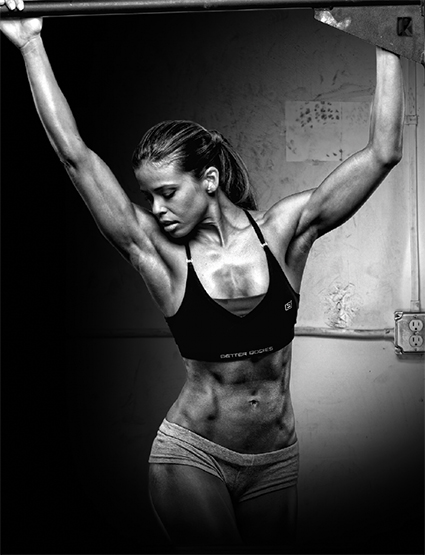
Treadmill
See those clothes hanging off your treadmill? It’s time to put them away and start putting the machine to use. This classic piece of cardio equipment may have been undervalued but is making a well-deserved comeback, mostly for its versatility. Although very basic versions of this machine may allow you to adjust only the speed of the belt, more comprehensive models also have adjustable inclines. This feature allows you to change the focus of the muscles in the lower body and makes you work harder in general, yielding a greater calorie burn as the intensity of output increases.

To change the stimulus, keep your speed at a brisk walking pace and turn up the incline. Pay attention to how your body needs to recruit more hamstrings and glutes, and how your calves even feel more of a burn. Want to maximize the challenge? Take a page from elite sprinters and soccer players and run some hill sprints. Turn up both the incline and the speed and see how many you can do.
Although jogging and running outdoors is more enjoyable because of the scenery and fresh air, weather may not always cooperate. Also, logging miles on asphalt can be tough on the knees and ankles. In these cases, the treadmill is a solid solution. Rain, snow, or humidity won’t cause you to skip your session, and the cushioning provided by the belt can alleviate some of the impact on your joints.
When it comes to calories burned, the treadmill yields a moderate rate per minute. Contrary to popular belief, running doesn’t burn as many calories per minute as many people think. For the time, effort, and strain on the body, the calorie output may not be worth it. If you need to stick to the treadmill but want to give your joints a break, skip the running and do a high-incline walk.
Treadmill Pros
• Versatile with the option to walk, incline walk, jog, or sprint
• Readily available at any gym or fitness club
• Appropriate for any fitness and skill level
• Belt provides cushioning
• If your gym doesn’t have stairs, using a treadmill on a high incline can be swapped in
Treadmill Cons
• Can be hard on the joints of the lower body
• Running and sprinting requires coordination and proper biomechanics to be executed at a high enough level to maximize benefits
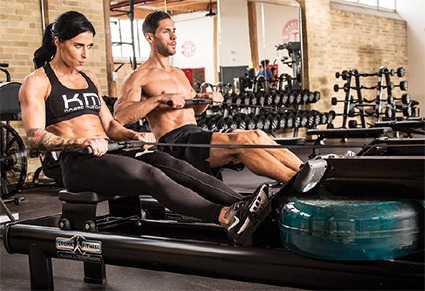
Rower
That’s right—the rower. This calorie-killer is often passed by without a second glance, which is unfortunate. People may be intimidated because it’s likely a new movement pattern to them, or because it’s just straight-up tough.
When executed properly, the full body needs to work together; the legs push hard to generate momentum, the lower back flexes, the core stabilizes, and the upper body contracts to row the handle in with as much force as possible. With so many muscles working at a peak level, the demand on the heart and lungs is high, which serves to boost your cardiovascular fitness.
When the full body works to its maximum capacity like this, the number of calories burned shoots through the roof. It’s estimated that the rower can burn 10 to 15 percent more calories than running or cycling does.
Rower Pros
• Recruits muscles from all major muscle groups for a big calorie burn
• No impact on joints
Rower Cons
• Requires full-body coordination to get the most benefit
• New movement pattern for most people
• Not all gyms have them (or they have very few)
• Initial lower back pain for newbies
Cardio + Abs
Combine intense cardio intervals with ab-specific recovery phases to burn fat and carve out your six-pack.
45–60-second sprint on the rower
1 min. ab work
Perform 5 rounds, moving immediately back and forth. Aim to add another round each week.
Ab suggestions: decline leg raises, crunches on an exercise ball, bicycle twists

Elliptical
Another overlooked piece of equipment is the elliptical. These machines may be intimidating to people who have never used one before as they have a lot of moving parts and the movement requires some coordination. However, once you get on the machine and start moving, the pattern is reasonably similar to a running stride without any impact.
As with all gym equipment, the elliptical is made to fit the average body. If you fall outside this average, or have different proportions (for example, short legs for your height), the machine’s movement pattern may not be right for you. As your foot placement is dictated by the pedals, you have very limited ability to change the stride mechanics.
Many machines in corporate gyms have the ability to adjust the resistance as well as the incline, allowing you to target different areas of the lower body. Crank the incline up and feel the heat move into your hamstrings and glutes as you make things more challenging.
Note: An ARC trainer is similar to an elliptical, but uses a slightly different movement path. Where the foot pedals of an elliptical move on a track in a straight line, the ARC moves in, well, an arc. This can be a more comfortable pattern for people, and also targets the legs differently, especially when the incline is increased. It becomes a combination of running and climbing stairs, with zero impact. If your gym has one, give it a try to mix things up.
Elliptical Pros
• Good workout for the legs if resistance and incline are used
• No impact on joints
• If your gym doesn’t have stairs, the elliptical can be swapped in (at a high incline)
Elliptical Cons
• Requires a moderate amount of coordination
• Stride pattern set by the machine may not be compatible for everyone, leading to knee or hip pain
Dive In
Swimming is an overlooked form of cardio, but it shouldn’t be. Not only is it incredibly taxing for the heart and lungs, giving you a huge boost in cardiovascular fitness, but it’s also a great full-body workout. Have you seen the shoulders and lats on an Olympic swimmer? Not only will it challenge you physically, but the water provides a great environment from many perspectives. There’s no impact on the joints, but the resistance from the water makes the muscles work harder than you can imagine. Try logging a few laps and see how long you last.
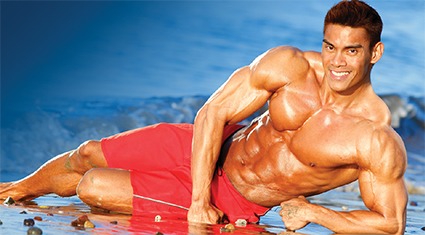
HIIT Freestyle Swim Workout
Warm up for 5–10 minutes. Start slowly and pick up the pace slightly every 2 laps.
Interval 1: Repeat 6 times
1. Sprint 1 lap (25 metres) freestyle
2. Recover 1 lap (25 metres) breaststroke
Interval 2: Repeat 4 times
1. Sprint 2 laps (50 metres) freestyle
2. Recover 1 lap (25 metres) breaststroke
Interval 3: Repeat 2 times
1. Sprint 4 laps (100 metres) freestyle
2. Recover 2 laps (50 metres) breaststroke
Recovery: 3 minutes slow pace any swim stroke
Repeat intervals 1, 2, & 3 with recovery 1–2 additional times
Finish with a 5-minute cooldown swim at slow pace.
Roll With It
When you want to mix things up with your cardio and get out in the sun, try strapping on a pair of in-line skates and heading to a bike path. The movement pattern involved will tax your legs and butt in a totally new way that you’ll feel for days. Plus, it’ll challenge your cardio capacity, your dynamic balance, and your core strength along with your lower back—all with minimal impact. As you get more skilled, focus on sinking down into your legs and pushing each stride as long as possible. This will keep the tension in your quads and improve your proprioception.
